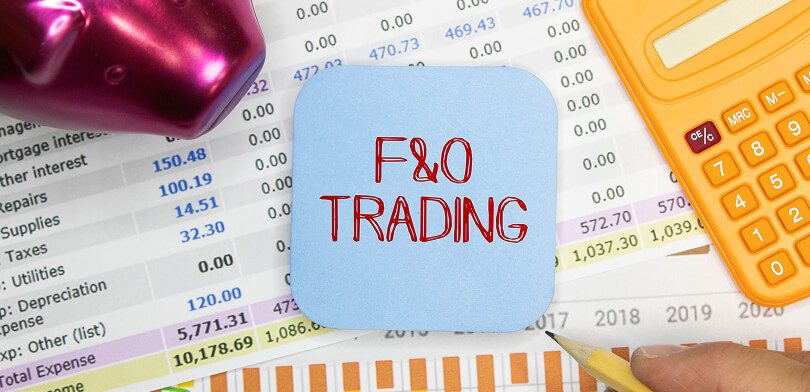The right strike price is a fundamental aspect of options trading, serving as the price at which an option can be exercised. An appropriate strike price is key to aligning trading strategies with market expectations and risk tolerance. This initial decision can significantly impact the profitability and success of options trades.
Topics Covered:
- Importance of Choosing the Right Strike Price
- Process to Pick the Right Strike Price – Step by Step Guide
Importance of Choosing the Right Strike Price
Strike price in options trading is not just a number—it’s a strategic decision that influences the outcome of an investment. It represents the price at which an option holder can buy (call option) or sell (put option) the underlying asset. This choice determines the intrinsic value of an option. It influences its time value, affecting the overall premium paid or received.
Step into the world of Futures & Options — Open your Demat account
Consequences of an Inappropriate Strike Price
Selecting a strike price strategy without due consideration can lead to several adverse outcomes. For one, choosing a price too far out of the money may result in the option expiring worthless if the market does not move as anticipated, leading to a total loss of the premium paid.
On the other hand, selecting a price too close to the market price without considering volatility might offer lower returns due to higher premiums, especially in a flat market.
Additional Read: Long Straddle in Options Trading
Benefits of a Well-Chosen Strike Price
A strategically selected strike price maximises the potential for profit while managing risk. For example, choosing a price slightly above the current market price for a call option in a bullish market can offer a good balance between cost and potential return. Similarly, a put option with a price slightly below the current market price can be advantageous in a bearish market.
The right strike price allows traders to leverage market movements, enhance returns on investment, and mitigate potential losses. Understanding and aligning it with one’s market view and risk appetite also helps craft a more resilient trading strategy. Ready to start implementing your trading strategy with precision? Open demat account today to access a wide range of options and execute trades efficiently.
Process to Pick the Right Strike Price – Step by Step Guide
Identify the Market
- Assess Market Conditions: Begin by analysing current market conditions. Consider if the market is bullish, bearish, or neutral. Each condition may affect the optimal strike price differently.
- Market Trends: Analyse longer-term market trends to predict future movement. Historical data and technical indicators can provide valuable insights.
- Volatility: Understand the level of volatility in the market. Higher volatility may affect premium prices, thus affecting your choice of these prices.
Additional Read: Expiry Day Options Buying Strategy
Decide on Your Options Strategy
- Directional Strategies: If you have a clear view of the market direction, choose a strike that aligns with your forecast. For bullish outlooks, consider in-the-money or at-the-money call options. For bearish outlooks, similar puts may be preferable.
- Neutral Strategies: Options trading strategies like iron condors or butterflies would suit a neutral market view. Strike prices for these strategies should focus on the range in which the underlying asset is expected to remain.
- Income Strategies: Selling options for income may involve out-of-the-money strikes where you believe the market won’t reach before expiration.
Consider Your Risk Profile
- Risk Appetite: Your choice of strike price should reflect your risk tolerance. More conservative traders might prefer in-the-money options with higher premiums but higher probabilities of profit.
- Capital Allocation: Determine how much of your capital you will risk on an options trade, which may impact the prices you consider feasible.
- Timeframe: Your investment time horizon plays a crucial role. Short-term traders may select strikes closer to the money, while longer-term traders may opt for deeper out-of-the-money strikes with more time to expiration.
Additional Read: Straddle Options Strategy
Take the Time to Carry Out Analysis
- Technical Analysis: Use chart patterns, trend lines, and indicators to identify potential turning points, support, and resistance levels that might influence strike price selection.
- Fundamental Analysis: For stock options, assessing the company’s fundamentals can forecast long-term price direction, informing your price choice.
- Options Greeks: Analyse Delta, Theta, and Vega to understand how the option’s price could change with movements in the underlying asset, time decay, and volatility.
Additionally Read: About Demat Account
Work Out the Value of Your Option and Pick Your Strike Price
- Intrinsic and Extrinsic Value: Calculate both values to determine how much of the option’s price is worth compared to the time and volatility premium.
- Break-Even Point: Factor in the premium paid to determine your break-even point. This can help assess what price offers a favourable cost-to-benefit ratio.
- Open Interest and Volume: High open interest and volume indicate a more active and liquid options market, potentially making it easier to enter and exit positions.
Open an Account and Place Your Trade
- Choosing a Broker: Select a reputable broker offering a robust trading account that supports the options strategies you intend to execute.
- Trade Execution: With your account set up, place your trade according to your chosen options strategy and strike price. Ensure that you use the correct order type to manage risk effectively.
- Follow-Up: Monitor your options trade and be prepared to make adjustments as market conditions change.
Additional Read: Why Options are Essential for Investors?
Final Words
Understanding how to pick the right strike price is vital for options trading. This decision hinges on multiple factors, including market assessment, strategy choice, risk consideration, thorough analysis, and careful selection based on intrinsic value and market activity. Mastery of these aspects can enhance your trading outcomes, leading to more strategic, informed, and effective options trading investments.











